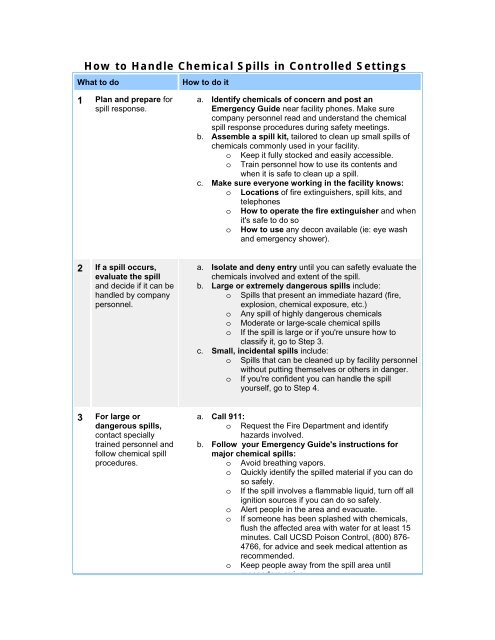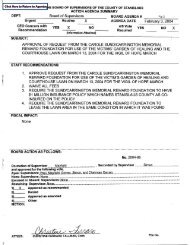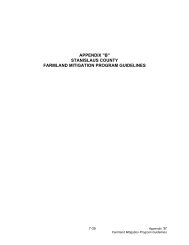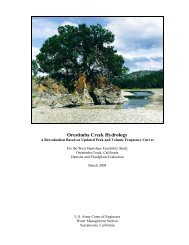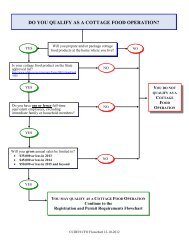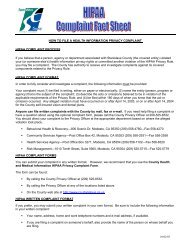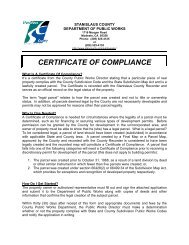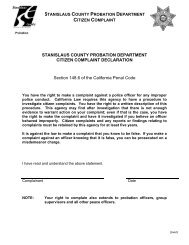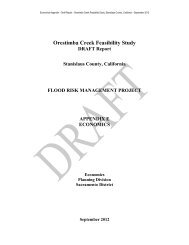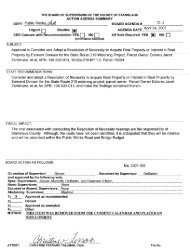Guidelines on how to handle chemical spills in controlled settings
Guidelines on how to handle chemical spills in controlled settings
Guidelines on how to handle chemical spills in controlled settings
You also want an ePaper? Increase the reach of your titles
YUMPU automatically turns print PDFs into web optimized ePapers that Google loves.
How <strong>to</strong> Handle Chemical Spills <strong>in</strong> C<strong>on</strong>trolled Sett<strong>in</strong>gs<br />
What <strong>to</strong> do<br />
How <strong>to</strong> do it<br />
1 Plan and prepare for<br />
spill resp<strong>on</strong>se.<br />
a. Identify <strong>chemical</strong>s of c<strong>on</strong>cern and post an<br />
Emergency Guide near facility ph<strong>on</strong>es. Make sure<br />
company pers<strong>on</strong>nel read and understand the <strong>chemical</strong><br />
spill resp<strong>on</strong>se procedures dur<strong>in</strong>g safety meet<strong>in</strong>gs.<br />
b. Assemble a spill kit, tailored <strong>to</strong> clean up small <strong>spills</strong> of<br />
<strong>chemical</strong>s comm<strong>on</strong>ly used <strong>in</strong> your facility.<br />
o Keep it fully s<strong>to</strong>cked and easily accessible.<br />
o Tra<strong>in</strong> pers<strong>on</strong>nel <strong>how</strong> <strong>to</strong> use its c<strong>on</strong>tents and<br />
when it is safe <strong>to</strong> clean up a spill.<br />
c. Make sure every<strong>on</strong>e work<strong>in</strong>g <strong>in</strong> the facility knows:<br />
o Locati<strong>on</strong>s of fire ext<strong>in</strong>guishers, spill kits, and<br />
teleph<strong>on</strong>es<br />
o How <strong>to</strong> operate the fire ext<strong>in</strong>guisher and when<br />
it's safe <strong>to</strong> do so<br />
o How <strong>to</strong> use any dec<strong>on</strong> available (ie: eye wash<br />
and emergency s<strong>how</strong>er).<br />
2 If a spill occurs,<br />
evaluate the spill<br />
and decide if it can be<br />
<strong>handle</strong>d by company<br />
pers<strong>on</strong>nel.<br />
a. Isolate and deny entry until you can safetly evaluate the<br />
<strong>chemical</strong>s <strong>in</strong>volved and extent of the spill.<br />
b. Large or extremely dangerous <strong>spills</strong> <strong>in</strong>clude:<br />
o Spills that present an immediate hazard (fire,<br />
explosi<strong>on</strong>, <strong>chemical</strong> exposure, etc.)<br />
o Any spill of highly dangerous <strong>chemical</strong>s<br />
o Moderate or large-scale <strong>chemical</strong> <strong>spills</strong><br />
o If the spill is large or if you're unsure <strong>how</strong> <strong>to</strong><br />
classify it, go <strong>to</strong> Step 3.<br />
c. Small, <strong>in</strong>cidental <strong>spills</strong> <strong>in</strong>clude:<br />
o Spills that can be cleaned up by facility pers<strong>on</strong>nel<br />
without putt<strong>in</strong>g themselves or others <strong>in</strong> danger.<br />
o If you're c<strong>on</strong>fident you can <strong>handle</strong> the spill<br />
yourself, go <strong>to</strong> Step 4.<br />
3 For large or<br />
dangerous <strong>spills</strong>,<br />
c<strong>on</strong>tact specially<br />
tra<strong>in</strong>ed pers<strong>on</strong>nel and<br />
follow <strong>chemical</strong> spill<br />
procedures.<br />
a. Call 911:<br />
o Request the Fire Department and identify<br />
hazards <strong>in</strong>volved.<br />
b. Follow your Emergency Guide's <strong>in</strong>structi<strong>on</strong>s for<br />
major <strong>chemical</strong> <strong>spills</strong>:<br />
o Avoid breath<strong>in</strong>g vapors.<br />
o Quickly identify the spilled material if you can do<br />
so safely.<br />
o If the spill <strong>in</strong>volves a flammable liquid, turn off all<br />
igniti<strong>on</strong> sources if you can do so safely.<br />
o Alert people <strong>in</strong> the area and evacuate.<br />
o If some<strong>on</strong>e has been splashed with <strong>chemical</strong>s,<br />
flush the affected area with water for at least 15<br />
m<strong>in</strong>utes. Call UCSD Pois<strong>on</strong> C<strong>on</strong>trol, (800) 876-<br />
4766, for advice and seek medical attenti<strong>on</strong> as<br />
recommended.<br />
o Keep people away from the spill area until<br />
resp<strong>on</strong>ders arri e
esp<strong>on</strong>ders arrive.<br />
o Have some<strong>on</strong>e available who is knowledgeable<br />
about the spilled material <strong>to</strong> provide <strong>in</strong>formati<strong>on</strong><br />
<strong>to</strong> <strong>in</strong>com<strong>in</strong>g resp<strong>on</strong>ders.<br />
4 Clean up small<br />
<strong>spills</strong> accord<strong>in</strong>g <strong>to</strong><br />
these guidel<strong>in</strong>es.<br />
a. Alert people <strong>in</strong> the area. Avoid breath<strong>in</strong>g vapors and try<br />
<strong>to</strong> determ<strong>in</strong>e what spilled.<br />
b. If some<strong>on</strong>e has been splashed with <strong>chemical</strong>s,<br />
immediately flush the affected area with water for at least<br />
15 m<strong>in</strong>utes. Call UCSD Pois<strong>on</strong> C<strong>on</strong>trol, (800) 876-4766,<br />
and seek medical attenti<strong>on</strong> as recommended.<br />
c. Wear pers<strong>on</strong>al protective equipment <strong>in</strong>clud<strong>in</strong>g safety<br />
goggles, gloves and appropriate cloth<strong>in</strong>g dur<strong>in</strong>g cleanup.<br />
d. C<strong>on</strong>f<strong>in</strong>e the spill <strong>to</strong> a small area. Use appropriate<br />
absorbent material from your spill kit <strong>to</strong> absorb spilled<br />
materials.<br />
o Place any c<strong>on</strong>tam<strong>in</strong>ated absorbent <strong>in</strong> c<strong>on</strong>ta<strong>in</strong>er.<br />
o Label the c<strong>on</strong>ta<strong>in</strong>er with a <strong>chemical</strong> waste label<br />
and <strong>in</strong>clude it <strong>in</strong> the next hazardous waste<br />
collecti<strong>on</strong>.<br />
e. Clean the spill area.<br />
f. Replenish your spill kit supplies, so the kit is ready<br />
when you need it.


